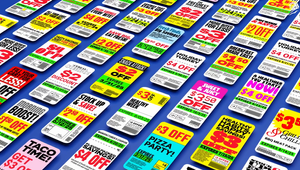
Is Quick-Turn Creator Content the Future of Influencer Marketing?

'Influencer Marketing: A Need for Speed in Content Creation' is the new white paper from VML's influencer marketing agency, Obviously. The insights within show how brands can have creator content that is fast and efficient - without sacrificing authenticity.
Nowadays, there is a heightened importance on brands capitalising on trends. Trends, of course, which are trending for a reason - that being, people are interested and captivated by the ideas they present in that, albeit often quite fleeting, moment.
The white paper shows how branded content on platforms like TikTok and Instagram experience greater engagement - at least a 20% boost - when linked to fast moving social trends. However, the research emphasises the importance of not approaching creators today in a ‘celebrity endorsement’-style. These partnerships, says Obviously, must be ‘quick-turn content’ produced by members of an established ‘creator network’ around the brand - long-term collaborators with agency over the content they publish.
LBB’s Ben Conway caught up with Mae Karwowski, CEO and founder of Obviously, to discuss the findings of the white paper - which you can read in full here - and explore the latest influencer trends.

Above: Mae Karwowski, CEO, Founder of Obviously
LBB> The report says that creator marketing is projected to be valued at $41.8 billion by 2025, up from $27.5 billion in 2003, and that 80% of brands now spend more on influencer marketing than on traditional creative. What is driving this growth in interest and investment in creator marketing?
Mae> People are spending two to four hours a day on social media, so brands want to meet their customers where they are. People form strong bonds with the creators they follow, so it makes sense that there are measurable sales increases when influencers are talking about specific brands.
LBB> One of the white paper’s main points is that brands are missing out on macro and micro trends by approaching creators in a traditional ‘celebrity endorsement’-style. Why is that approach unsuccessful today?
Mae> In this white paper, we talk through the results of quick-turn content and building long term relationships with influencers. These strategies are so effective because they are designed for both the fast moving nature of social media, and also the market economics of working with creators. The old school ‘put a celeb in your TV commercial and on a billboard’ approach needs to be updated to the reality that people spend more time on social media now than ever, and creators’ content on social media needs to be relevant and in the moment to drive outsized performance.
LBB> The white paper instead recommends that brands deploy ‘quick-turn campaigns’ - can you briefly explain what those are?
Mae> We build a creator network for a brand, and those creators pitch ideas consistently to the brand team about trends they’re seeing and videos they’re thinking of making. Once the brand says ‘yes!’, the creator makes the video, submits it, and it’s out in the world in as little as 48 hours.

LBB> How can marketers/agencies find and develop these networks?
Mae> To build a creator network you need to commit to fostering relationships with creators, and to have projects you’d love to work on with these influencers. You need to identify the creators you want to partner with, reach out to them, engage them with campaign concepts, products, and the vision for the brand, and then get them working with you. You then need to measure performance and keep track of these few hundred to few thousand people.
We take care of all of the above for brands so they can focus on creating strong relationships. It’s a lot to manage, and to do so incredibly quickly you need tech like the platform we’ve built to make this all possible.
LBB> The research also shows that quick-turn campaigns have greater engagement, and cost around 25% less per post than one-off campaigns, on both Instagram and TikTok. How come these long-term relationships with large networks of creators are more cost efficient?
Mae> Put yourself in the shoes of the creator for a second. Say you’re a tennis influencer on TikTok. If you genuinely love a racket brand and talk about it all the time, you’d be so excited to partner with that brand! You’re growing your audience and trying to increase your ability to monetise your content. You’d (typically) be willing to take a lower rate per piece of content if the brand agreed to a tonne more work together, rather than just doing one piece of content and not continuing the relationship.
LBB> The paper highlights that with quick-turn content, creators are free agents and can choose whether they engage with a trend or not. Wouldn’t some brands prefer to have total control? What is the benefit of this level of creator autonomy for brands?
Mae> TL;DR: The content is way better when the creator has more control. There are real guardrails here; brands get to approve and add input to all ideas and all content from influencers before it’s published.
Brands can always make ads for themselves on these social channels - and they totally should. But when a brand is working with a creator, the creativity needs to come from that person, and they need to be able to act quickly. That’s what we see in the data.
LBB> The white paper outlines four steps for success: an always-on creator network, fostering relationships with the talent, a system that identifies trends, and building a library of reusable, creator-produced content. What are some of the main challenges/barriers that agencies and brands are facing when trying to achieve these things?
Mae> It’s hard to get all this done. Most brands get lost in the details, and for good reason - it takes a ton of coordination. We’ve found on average over 9,000 messages sent back and forth from a brand to creators on a 50 influencer campaign. So if you do not have the team power or the tech, it can be incredibly difficult to get to scale. And you need the scale to unlock the results.















